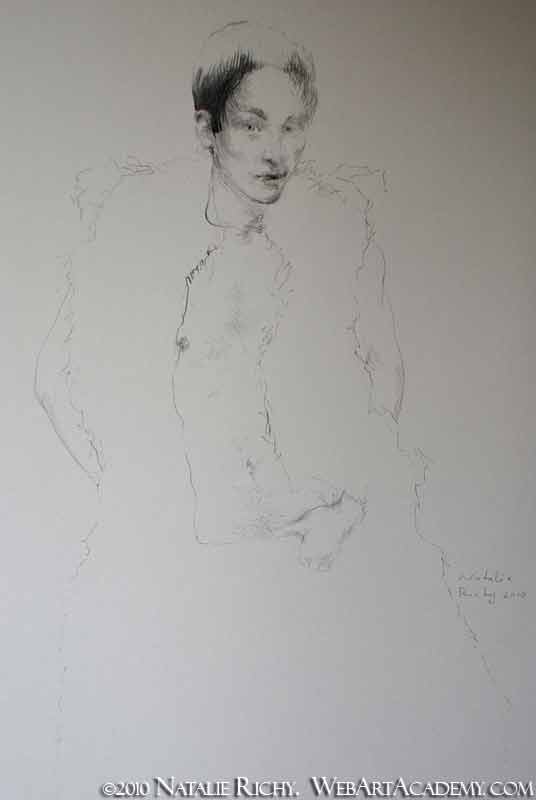Video Lesson: Graphite on Paper. How to draw a portrait.
This Video Lesson presents an example of making two drawings in which you will learn how to draw relying on unique lose strokes only. You will be able to create your drawings fast, freshly, impressive, emotionally fulfilled and reminding the etching effect. Such technique is great for both preparatory sketches and finished artworks.
Video is based on two drawings made by Natalie Richy.
Here is another good example of portrait drawing where you can achieve great results with a minimalist approach. This drawing is done in the same style as the previous one. Graphite drawing techniques are virtually endless. Any way that you choose to apply graphite to a surface will produce some sort of interesting result.
To begin with, we are indicating the overall contours of the figure with very light pencil strokes. Going forward, these initial strokes will be improved and corrected as required. At this point we are also making a sketch of the facial features. Using stand-alone strokes, we are outlining the facial features and immediately working on these features in more detail. The essential shape is depicted with hatching. To keep the drawing fresh, we most likely would not return to these places later on for additional drawing. This approach is very intuitive. If you see good strokes it is better to leave them alone, rather than spoiling things by overdoing the pencil hatching. In the case of our drawing it is better to keep it fresh and unfinished – the fewer strokes, and the more precise the strokes are, the better.
Experiment with the strokes. You should vary the strokes to make the drawing more interesting. You can notice how strokes are following the round contour beside the left eye. It is good practice to keep strokes following the contour of shapes. You may also notice the strokes on the upper lip going vertically and at angles to create the effect of shadow.
Long strokes are used along the collar and especially on the hair. You should also vary the stroke pressure. For example, the pressure is much stronger when sketching the hair than when drawing other parts of the face.
To avoid the monotony of similar hatching you should vary not only the pressure but also the length and direction of the strokes, using various kinds of hatching. It is important to portray various objects and surfaces using different hatching methods. In our portrait, the hair, the skin and the cloth all use different kinds of hatching. Lifting the pencil towards the end of the stroke can be used to give a grassy or fluffy effect. It can be useful to apply less weight to the pencil at the start of the stroke, rather than applying full pressure right away.
To avoid giving the drawing an all-grey appearance, you may make dark accents in some places. In our drawing, the darkest area is on the hair. The pressure of the strokes on the paper in combination with differing pencil softness will deliver variations in tones. When drawing lines to shade a form, it is usually best to draw with the movement of the form. But there are times when you can get a better effect by drawing against the movement. Try many methods.
When drawing lines, either in a linear drawing or within a texture in a tonal drawing, note that you can vary the weight of the line by lifting the pencil or pressing harder. In certain places the strokes are weak and thin and in other places they are bold and strong; this combination of strokes adds some character to the drawing. You may also vary smooth and sharp broken strokes. The combination of the more completed face and the unfinished body and cloth, as well as the fine, rhythmic, almost poetic lines used, makes this drawing more interesting and harmonious. Remember that one of the beautiful things about good drawing is the rhythm and flow of the lines.



This Post Has 0 Comments